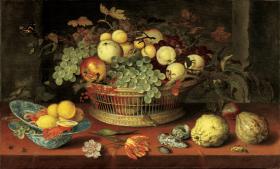
Exotic seashells, carefully observed insects and fruits, and rare hybrids of flowers were elements of the seventeenth-century Dutch fascination with the natural world. An extreme manifestation of this curiosity was “tulipomania,” the folly of collectors spending huge sums to acquire individual tulip bulbs such as the one that produced the striped variety in this still life. The shells are depicted with such exactitude that they can be identified as species from seas off the coasts of the East and West Indies and Africa. These and the Chinese porcelain are evidence of the extensive trading sphere of Dutch merchants.
Van der Ast specialized in paintings of such objects, admired for their verisimilitude to nature as well as for the moral associations attached to individual motifs. For example, the painter frequently followed the convention of scattering tiny creatures and spoiling fruit in pictures as reminders of the transitory nature of life. The butterfly, grasshopper, and fruit exist for only a brief span. The fading beauty of the cut flowers reinforces this idea, but like the shells, they may have offered criticism on the practice of squandering money on objects of curiosity. Interestingly, the fruits and flowers appear together although they come from different growing seasons. Like many of his contemporaries, Van der Ast would have utilized studies that he later combined in his compositions.

